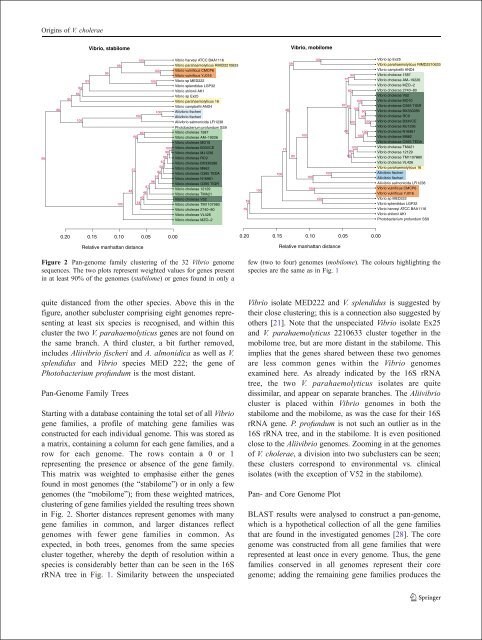Computational tools and Interoperability in Comparative ... - CBS
Computational tools and Interoperability in Comparative ... - CBS
Computational tools and Interoperability in Comparative ... - CBS
You also want an ePaper? Increase the reach of your titles
YUMPU automatically turns print PDFs into web optimized ePapers that Google loves.
Orig<strong>in</strong>s of V. cholerae<br />
68<br />
68<br />
93<br />
64<br />
64<br />
95<br />
100<br />
Vibrio, stabilome<br />
0.20 0.15 0.10 0.05 0.00<br />
Relative manhattan distance<br />
quite distanced from the other species. Above this <strong>in</strong> the<br />
figure, another subcluster compris<strong>in</strong>g eight genomes represent<strong>in</strong>g<br />
at least six species is recognised, <strong>and</strong> with<strong>in</strong> this<br />
cluster the two V. parahaemolyticus genes are not found on<br />
the same branch. A third cluster, a bit further removed,<br />
<strong>in</strong>cludes Aliivibrio fischeri <strong>and</strong> A. almonidica as well as V.<br />
splendidus <strong>and</strong> Vibrio species MED 222; the gene of<br />
Photobacterium profundum is the most distant.<br />
Pan-Genome Family Trees<br />
99<br />
99<br />
100<br />
48<br />
100<br />
100<br />
98<br />
98<br />
67<br />
Vibrio harveyi ATCC BAA1116<br />
Vibrio parahaemolyticus RIMD2210633<br />
Vibrio vulnificus CMCP6<br />
Vibrio vulnificus YJ016<br />
Vibrio sp MED222<br />
Vibrio splendidus LGP32<br />
Vibrio shilonii AK1<br />
Vibrio sp Ex25<br />
Vibrio parahaemolyticus 16<br />
Vibrio campbellii AND4<br />
Aliivibrio fischeri<br />
Aliivibrio fischeri<br />
Aliivibrio salmonicida LFI1238<br />
Photobacterium profundum SS9<br />
Vibrio cholerae 1587<br />
Vibrio cholerae AM 19226<br />
Vibrio cholerae MO10<br />
Vibrio cholerae B33VCE<br />
Vibrio cholerae MJ1236<br />
Vibrio cholerae RC9<br />
Vibrio cholerae BX330286<br />
Vibrio cholerae M662<br />
Vibrio cholerae O395 TEDA<br />
Vibrio cholerae N16961<br />
Vibrio cholerae O395 TIGR<br />
Vibrio cholerae 12129<br />
Vibrio cholerae TMA21<br />
Vibrio cholerae V52<br />
Vibrio cholerae TM1107980<br />
Vibrio cholerae 2740 80<br />
Vibrio cholerae VL426<br />
Vibrio cholerae MZO 2<br />
Start<strong>in</strong>g with a database conta<strong>in</strong><strong>in</strong>g the total set of all Vibrio<br />
gene families, a profile of match<strong>in</strong>g gene families was<br />
constructed for each <strong>in</strong>dividual genome. This was stored as<br />
a matrix, conta<strong>in</strong><strong>in</strong>g a column for each gene families, <strong>and</strong> a<br />
row for each genome. The rows conta<strong>in</strong> a 0 or 1<br />
represent<strong>in</strong>g the presence or absence of the gene family.<br />
This matrix was weighted to emphasise either the genes<br />
found <strong>in</strong> most genomes (the “stabilome”) or <strong>in</strong> only a few<br />
genomes (the “mobilome”); from these weighted matrices,<br />
cluster<strong>in</strong>g of gene families yielded the result<strong>in</strong>g trees shown<br />
<strong>in</strong> Fig. 2. Shorter distances represent genomes with many<br />
gene families <strong>in</strong> common, <strong>and</strong> larger distances reflect<br />
genomes with fewer gene families <strong>in</strong> common. As<br />
expected, <strong>in</strong> both trees, genomes from the same species<br />
cluster together, whereby the depth of resolution with<strong>in</strong> a<br />
species is considerably better than can be seen <strong>in</strong> the 16S<br />
rRNA tree <strong>in</strong> Fig. 1. Similarity between the unspeciated<br />
100<br />
80<br />
66<br />
37<br />
54<br />
100<br />
98<br />
67<br />
46<br />
Figure 2 Pan-genome family cluster<strong>in</strong>g of the 32 Vibrio genome<br />
sequences. The two plots represent weighted values for genes present<br />
<strong>in</strong> at least 90% of the genomes (stabilome) or genes found <strong>in</strong> only a<br />
40<br />
100<br />
100<br />
58<br />
82<br />
91<br />
59<br />
59<br />
100<br />
100<br />
71<br />
48<br />
Vibrio, mobilome<br />
59<br />
80<br />
100<br />
100<br />
100<br />
0.20 0.15 0.10 0.05 0.00<br />
100<br />
100<br />
100<br />
Relative manhattan distance<br />
Vibrio isolate MED222 <strong>and</strong> V. splendidus is suggested by<br />
their close cluster<strong>in</strong>g; this is a connection also suggested by<br />
others [21]. Note that the unspeciated Vibrio isolate Ex25<br />
<strong>and</strong> V. parahaemolyticus 2210633 cluster together <strong>in</strong> the<br />
mobilome tree, but are more distant <strong>in</strong> the stabilome. This<br />
implies that the genes shared between these two genomes<br />
are less common genes with<strong>in</strong> the Vibrio genomes<br />
exam<strong>in</strong>ed here. As already <strong>in</strong>dicated by the 16S rRNA<br />
tree, the two V. parahaemolyticus isolates are quite<br />
dissimilar, <strong>and</strong> appear on separate branches. The Aliivibrio<br />
cluster is placed with<strong>in</strong> Vibrio genomes <strong>in</strong> both the<br />
stabilome <strong>and</strong> the mobilome, as was the case for their 16S<br />
rRNA gene. P. profundum is not such an outlier as <strong>in</strong> the<br />
16S rRNA tree, <strong>and</strong> <strong>in</strong> the stabilome. It is even positioned<br />
close to the Aliivibrio genomes. Zoom<strong>in</strong>g <strong>in</strong> at the genomes<br />
of V. cholerae, a division <strong>in</strong>to two subclusters can be seen;<br />
these clusters correspond to environmental vs. cl<strong>in</strong>ical<br />
isolates (with the exception of V52 <strong>in</strong> the stabilome).<br />
Pan- <strong>and</strong> Core Genome Plot<br />
99<br />
77<br />
100<br />
67<br />
82<br />
100<br />
90<br />
90<br />
100<br />
89<br />
89<br />
Vibrio sp Ex25<br />
Vibrio parahaemolyticus RIMD2210633<br />
Vibrio campbellii AND4<br />
Vibrio cholerae 1587<br />
Vibrio cholerae AM 19226<br />
Vibrio cholerae MZO 2<br />
Vibrio cholerae 2740 80<br />
Vibrio cholerae V52<br />
Vibrio cholerae MO10<br />
Vibrio cholerae O395 TIGR<br />
Vibrio cholerae BX330286<br />
Vibrio cholerae RC9<br />
Vibrio cholerae B33VCE<br />
Vibrio cholerae MJ1236<br />
Vibrio cholerae N16961<br />
Vibrio cholerae M662<br />
Vibrio cholerae O395 TEDA<br />
Vibrio cholerae TMA21<br />
Vibrio cholerae 12129<br />
Vibrio cholerae TM1107980<br />
Vibrio cholerae VL426<br />
Vibrio parahaemolyticus 16<br />
Aliivibrio fischeri<br />
Aliivibrio fischeri<br />
Aliivibrio salmonicida LFI1238<br />
Vibrio vulnificus CMCP6<br />
Vibrio vulnificus YJ016<br />
Vibrio sp MED222<br />
Vibrio splendidus LGP32<br />
Vibrio harveyi ATCC BAA1116<br />
Vibrio shilonii AK1<br />
Photobacterium profundum SS9<br />
BLAST results were analysed to construct a pan-genome,<br />
which is a hypothetical collection of all the gene families<br />
that are found <strong>in</strong> the <strong>in</strong>vestigated genomes [28]. The core<br />
genome was constructed from all gene families that were<br />
represented at least once <strong>in</strong> every genome. Thus, the gene<br />
families conserved <strong>in</strong> all genomes represent their core<br />
genome; add<strong>in</strong>g the rema<strong>in</strong><strong>in</strong>g gene families produces the<br />
65<br />
82<br />
100<br />
100<br />
100<br />
100<br />
few (two to four) genomes (mobilome). The colours highlight<strong>in</strong>g the<br />
species are the same as <strong>in</strong> Fig. 1









